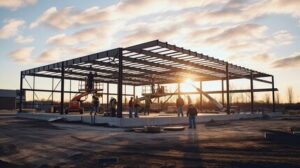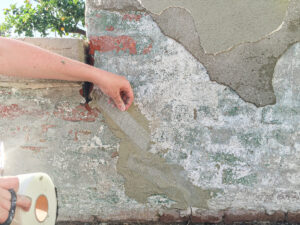Commercial Steel Buildings are the ideal solution for many different types of businesses. From veterinarian clinics to animal hospitals and warehouses, they can be easily customized to fit the needs of any business.

Construction times are significantly less than with other types of buildings, allowing businesses to start making revenue sooner. Click Here to learn more.
Steel buildings are a versatile construction option, with plenty of room for customization and expansion to suit changing needs. They also offer superior strength and durability to resist weather conditions such as high winds, heavy snow loads, and seismic activity. Additionally, they are highly resistant to mold, mildew, and pests, making them a great choice for commercial storage and retail locations.
One of the main reasons that steel buildings are so versatile has to do with their design. Since these structures don’t require support columns, they can typically be built with an open floor plan. This can make it easier for businesses to set up displays and organize inventory. Additionally, most steel building providers these days use sophisticated CAD technology to help clients create designs that are both functional and beautiful. As a result, the flexibility that these types of buildings can provide is unrivaled in terms of other construction options.
The versatility of commercial steel buildings also extends to their cost efficiency and sustainability. They are typically less expensive to build than a similar structure constructed from brick or concrete, and they are known for offering savings in maintenance costs over time. Steel buildings are durable and long-lasting, meaning that they will likely last longer than a wooden building, which can save on repair costs over time.
Ultimately, these benefits are why many people choose to purchase and construct a commercial steel building. The versatility and affordability of these types of buildings allow them to serve a wide range of commercial purposes, from warehouses to veterinary clinics and animal hospitals. Plus, their energy-efficiency and sustainability are a major selling point for those who want to invest in a green project.
If you’re interested in purchasing or constructing a commercial steel building, speak with a local provider to learn more about the process. Look for a company that offers customer support and can answer any questions you may have. This will help ensure that you’re getting the most out of your investment. With the right provider, you can be sure that your new commercial building will meet all of your business’s needs now and for years to come.
Cost-Effectiveness
Steel buildings are often less expensive to build than traditional structures. They also require much less maintenance over the years, resulting in significant savings. Additionally, because they are resistant to fire and other damage, insurance costs are lower than with wood constructions. This translates into substantial financial benefits for your business in the long run.
Commercial steel buildings can be customized to suit a wide range of applications. They can be designed for office space, retail spaces, or service applications, such as garages, auto repair shops, towing companies, and cold storage facilities. Moreover, they can be adapted to fit the needs of agricultural businesses, as well as warehouses and equestrian centers. The high level of customization available for these structures allows you to add features like insulated walls, air conditioning, doors, windows, and more, creating a space that suits your specific needs.
In addition to being cost-effective, steel buildings are also environmentally friendly and can be constructed quickly. This means they are a great choice for those who want to get their business up and running as quickly as possible. Steel and stud buildings are also durable and can hold heavy equipment, making them ideal for warehouses or other industrial settings.
Another advantage of a steel building is that it can withstand harsh weather conditions and seismic events. This makes it a great option for those who live in an area that has a lot of storms or earthquakes. Additionally, the structure is fire resistant, which can protect occupants in case of an emergency.
Choosing the right metal building for your business can be tricky, but with the help of a knowledgeable company, you can make an informed decision that will benefit your company. Contact a company such as Steel and Stud today to learn more about the different options available and how they can work for your business. Their team can help you create a custom building that will meet all of your requirements and give your business the right space for success.
Durability
The longevity of steel building materials is one of the main reasons why they’re preferred for a range of commercial projects. Unlike buildings made of traditional construction materials, they don’t require the same level of maintenance and repair. Steel buildings are durable, dimensionally stable, and resistant to common causes of degradation like mold, mildew, and moisture. Additionally, they’re designed to withstand natural disasters like severe winds and heavy snow or rain. Finally, they’re non-combustible and can withstand fires without melting or burning.
Whether you’re planning a garage, workshop, warehouse, office space, or other commercial project, it’s essential to choose the right materials and design for your building. With advances in steel production and protective coatings, steel is more durable and sustainable than ever. These advancements have impacted everything from construction time to material costs, making steel an increasingly appealing choice for today’s businesses and commercial projects.
Steel is also highly versatile, allowing builders to achieve unique designs and architectural styles that would be impossible with other building materials. This versatility opens the door to endless possibilities in terms of function, efficiency, and visual appeal, and it’s a great fit for modern commercial projects that demand a lot from their structures.
Aside from their durability and sustainability, steel buildings are cost-efficient in the long run. Because they’re pre-engineered, they require less on-site construction and labor than other types of buildings, reducing their overall cost. Plus, they’re energy-efficient, resulting in lower heating and cooling expenses.
If you’re ready to see why so many people are turning to steel for their commercial projects, contact a reputable contractor you can trust. Experts in steel construction, like Calahan Construction, will help you navigate the process of choosing the best material for your vision and goals. With the right information and support, you’ll be able to build something that not only looks good, but works well too! Contact us today to get started. We’ll provide you with a free quote and consultation so you can start your project on the right foot. Then, you can begin enjoying your new commercial space as soon as possible!
Sustainability
With sustainability becoming increasingly important for facility professionals, choosing green construction methods is a top priority. Steel structures are a great option for environmentally conscious customers looking to minimize their carbon footprint.
Steel is a sustainable building material in many ways, ranging from energy efficiency to recyclability. The most obvious reason for this is that it’s a durable material that lasts much longer than other types of structures, meaning less money spent on repairs and replacements over time. Steel buildings can also be expanded and modified as needs change without the need for major renovations. This can reduce the need for new construction, which uses additional materials and creates more waste.
Another sustainable aspect of steel is that it requires fewer chemicals than other materials to maintain its structure. Lumber is prone to pest infestations and other problems that require the use of heavy, expensive insecticides, while steel is naturally resistant to these issues. Additionally, steel buildings don’t absorb moisture, which can cause cracking and discoloration of other materials over time.
Steel building construction is also more sustainable from a supply-chain perspective. The prefabricated components of a steel building can be fabricated off-site and then delivered to the site, reducing the need for on-site labor and equipment emissions. Furthermore, most steel construction waste is recycled, compared to job-site waste in traditional buildings that often ends up in landfills.
Finally, metal structures are far more energy efficient than other types of structures. Because steel is so strong, it can support thicker sheets of insulation, which results in less air leakage and a more efficient heating and cooling system that cuts down on energy usage.
All of these factors contribute to the superior sustainability of Commercial Steel Buildings. If you’re interested in learning more about this type of construction or would like a quote on a steel structure, contact the friendly team at Titan Steel Structures today. We’ll be happy to answer any questions or concerns you may have and help you find the perfect steel building for your project.
